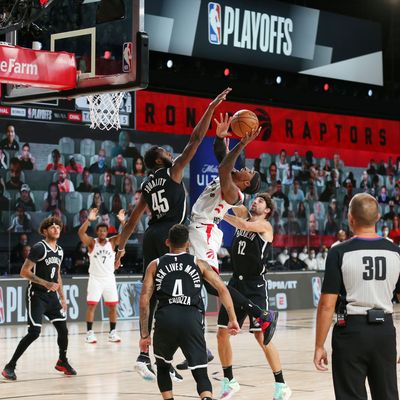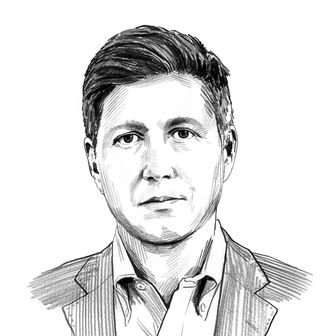
On Monday, after two final, heavily delayed weeks of the regular-season, the NBA Playoffs began. As is always the case, there are story lines everywhere: Can LeBron James win a title for the Lakers? Will soon-to-be-two-time MVP Giannis Antetokounmpo capture his first championship? Just how much will beloved broadcaster Doris Burke roast her ex-husband on live national television? But the most astonishing aspect of this year’s playoffs is that they are happening at all.
It’s difficult to point to many success stories during this sorry time in American history, but it is undeniable that the NBA is one of them. Think about what the league had to do to pull this off. It had to usher hundreds of men in their 20s and 30s — from different backgrounds, different familial situations, and different geographic bases (many of which are international) — into a carefully constructed bubble in the middle of a pandemic, in Florida, of all places. The league has not only kept all of those players safe — of the 342 players and staff in the Orlando bubble tested since July 29, the date of the NBA restart, not a single player has tested positive for COVID-19 — it has also created an atmosphere agreeable enough that many are playing the best, most exciting basketball of their lives. (ESPN’s great Zach Lowe reported on his podcast this week that players said they’ve never been more rested and in better condition. “We just play and go back to our hotel and sleep,” he quoted one as saying.)
Zero positive tests, during a time when the virus has been exploding across the country, is an achievement that shouldn’t be understated. The NBA has really pulled this off. And it’s not alone. The NHL has seen zero positive tests since its season started in late July as well — though, to be fair, the league is playing in Canada, which is perhaps an easier place to make this happen right now than Florida, or America. And for all the talk about Major League Baseball’s troubles with the St. Louis Cardinals and the Miami Marlins, and the perils of having no bubble at all, you can make an argument that it’s doing dramatically better than the country as a whole as well. Other than the Cardinals outbreak — which was bad, but now under control — MLB has had exactly one positive test in two weeks, out of more than 12,000. And that’s as teams travel across the country, staying in public hotels. The game is going on, and the positive-tests levels are dramatically, almost cartoonishly, lower than the nation’s at large. Sports are one of the few American institutions getting this right.
Well sure, you’re thinking, they have all that money to create this environment for themselves. That’s true, of course — though with no fans in the stands, there’s a lot less of that money than there was a year ago. And money by no means guarantees a successful strategy. If you’re looking for another rich institution that could have used its financial clout to make navigating COVID-19 easier, I point you to America itself. Just about every single thing the NBA, and those other sports leagues, has done correctly to get back to a simulacrum of normal business are steps the United States could have taken but didn’t. Why are sports back when nothing else in American life is? This is why.
1. Leagues were patient. After Utah Jazz center Rudy Gobert tested positive on March 11, NBA commissioner Adam Silver immediately shut down the league for a minimum of 30 days, and made no moves to rush back once those 30 days were up. It would be nearly three months until the league finalized its return-to-play plan, choosing Orlando and its Disney World bubble as the path forward. Every minute that passed between March and June brought the league dangerously closer to losing its season entirely, but Silver didn’t rush out of a desperate need to “reopen.” He waited until he had secured his bubble, his tests, and his players’ cooperation. The NHL’s process was similar. While MLB struggled with all sorts of labor issues in its return, it, too, followed a detailed, extensive protocol of testing and safety precautions for its return. The leagues waited until the last possible second to return to play. If anything, you can argue they waited too long; by the time they finally got going, COVID’s second wave (or the extension of its first) had come back around. But no one can say they rushed it.
2. They invested in testing. It is perfectly reasonable for someone like you or me to get angry about the near-daily COVID testing and rapid turnaround that professional athletes enjoy. (My last COVID test took ten days to get results, making it essentially meaningless. As Yahoo baseball writer Hannah Keyser put it, “Today I found out that 14 days ago I didn’t have coronavirus.”) Why should athletes get priority over teachers and students? And this is a valid point! All of us should be able to get tested easily and quickly! But that fact does not inherently mean that what leagues are doing is wrong. The reason they have all of this access to testing is simple: Having decided they would be unable to open their businesses without it, they forked over some money. Your employer (if you have one anymore) should have done the same thing. The federal government should have done the same thing. The question is not why sports leagues have made having tests for their employees such a priority. The question is why so few others in this country have.
3. They worked with local municipalities to create safe spaces. Both the NBA and the NHL were seriously considering having their bubbles in Las Vegas, until this now-infamous interview the city’s mayor gave to CNN’s Anderson Cooper:
After that, both leagues sprinted in opposite directions, the NBA to Florida, the NHL to Canada. There, they enacted strict protocols that were agreed upon by the local authorities. NHL, WNBA, MLS, and NBA players and staff (as well as reporters) were required to quarantine in their rooms upon arrival. The bubbles have remained impressively tight, in part because of the cooperation between the league and local authorities. (It turns out that large institutions are physically capable of working with municipalities. Huh.) For all the trouble baseball had with the Canadian government, which refused to allow the Toronto Blue Jays to travel back and forth to their home stadium from the states without quarantining, forcing the team to play in Buffalo, it did work with every city and state it’s playing in to come up with a set of clear guidelines and protocols. And they’re stricter than you might think: This last weekend, reporters covering the St. Louis Cardinals were not allowed inside Chicago’s Guaranteed Rate Field because they had so recently been in Missouri, a state considered a hot spot, and around a team that had experienced an outbreak, the Cardinals. Leagues didn’t just decree “We’re playing in your town, so figure it out!” They got where they are through months of negotiations and finely combed-over considerations.
4. They secured buy-in from everyone involved by emphasizing a collective spirit. This may be the most important one. For all the headlines that came out of an NBA player who reportedly went to a strip club outside the bubble, the incident was very much an exception. Players in every league, eager to get back to work and finish their season, have bought into the rules and treated following them as a source of pride, even team bonding. The Cleveland Indians recently suspended two players simply for going out to eat at a Chicago restaurant on a road trip, an activity not explicitly banned by MLB. And the response to this suspension by these players’ teammates was universal applause. Even in the contentious world of baseball’s labor relations, players are invested in finishing the season. LeBron James and Adam Silver have almost felt like partners in this process, rather than an employee and employer, or a president and the citizens he dictates to. There is a collective action involved, in which players call out other players who aren’t following the rules, in which everyone understands that they are on the same side and working for the same common goal. When I put it like that, it sounds a little like a fantasy world, doesn’t it?
The NBA and NHL have not licked this yet: They still both have their playoffs to complete, and the WNBA has its whole season. And, thanks to COVID-related postponements, it has been more than two weeks since all 30 MLB teams played on the same day. It is too early to say all the leagues have won. But by spending on testing, working with local officials, taking their time to have a plan in place, and getting everyone involved with the enterprise on the same page, leagues have done something that the federal government seems incapable or unwilling to do: They have gotten back to something vaguely resembling normal. They’ve returned because they have been cautious and they have utilized their vast resources wisely. If only we could say the same for the country.






























